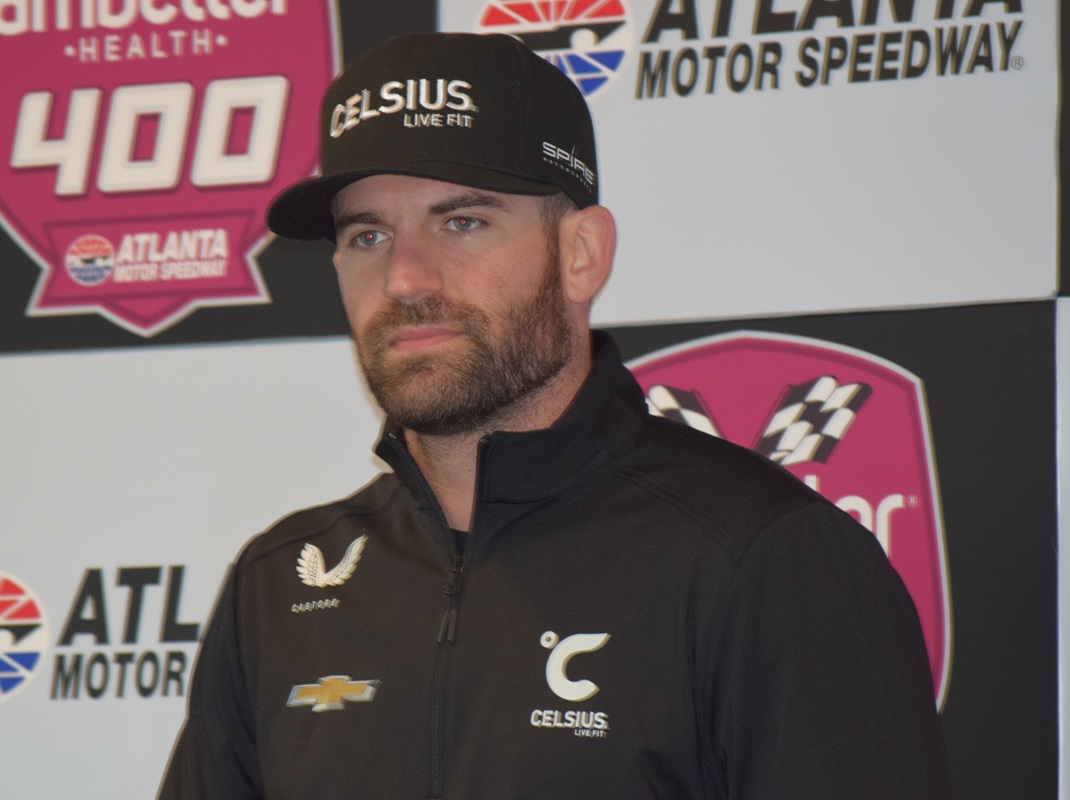LaJoie & Spire Carrying High Aspirations

Corey LaJoie hopes to capture his first NASCAR Cup Series win at Atlanta Motor Speedway this weekend. (Jacob Seelman photo)
HAMPTON, Ga. – Corey LaJoie has made it a point over Spire Motorsports’ recent progression not to circle any one step forward as a “seminal moment,” so to speak.
However, if someone were to do so from the outside looking in, last spring’s NASCAR Cup Series race at Atlanta Motor Speedway could, perhaps, be considered the team’s coming-out party.
It was in that race that LaJoie was in position at the white flag to potentially earn his first Cup Series victory, if not for one move in the draft that didn’t work out in the final mile-and-a-half of racing.
Since then, LaJoie has proven his mettle on drafting-style racetracks, earning three straight fourth-place finishes across the three superspeedways on the Cup Series schedule – Atlanta, Talladega (Ala.) Superspeedway, and Daytona (Fla.) Int’l Speedway.
But any chance to back to Atlanta, where his growth process took its first big leap one year ago, provides a sense of comfort to the second-generation driver – even if his confidence is as steady as ever.
“I have a lot of confidence every week. It’s just a case where drafting tracks aren’t as much of a handicap for the cars that I’ve had to drive the last couple years,” LaJoie explained. “But after the reconfiguration here, we've obviously run well. There was a time … that [pack racing] was my only opportunity to succeed. Now, we have the infrastructure as a team to succeed on short tracks, intermediates, and road courses as well.
“Coming in here, you don’t want to circle a speedway as your [only] chance to win, because a lot of it is out of your control. You can do your best to put yourself in a position to win, but sometimes it doesn’t bounce your way,” he continued. “We’ve done that pretty much every race here in Atlanta where we’ve been in position to win, and I believe we can do the same thing here again.”
The biggest difference, LaJoie tipped, between Atlanta and the two larger superspeedways is that things “tend to happen faster” because there’s a mile less of distance and a groove less in width compared to the pair of hallmark drafting tracks.
He compared racing in the draft to a chess game, with some variance when it comes to Atlanta, specifically. But the biggest pieces of pack racing still apply, LaJoie added, even on a smaller-sized oval.
“Here, it’s like speed chess,” LaJoie noted. “Daytona and Talladega, you can kind of see runs happening and forming and the energy of the lanes coming and going, and it’s all a bit slower. Here, the runs come and the holes open and close at, probably, double the speed of what they do at Daytona or Talladega. And much more of what you can do here at Atlanta comes down to handling, as well, so if you have a good handling car, then you can be aggressive whereas other guys have to roll out [of the throttle] whose cars are more trimmed out. Those guys are hanging on halfway through the run.
“We’ve had some really good driving cars here,” he added. “But you have to have some friends, too, because if you make that move to the bottom or a move for the lead and the guy behind you goes with the person you’re trying to pass, it’s not going to work out. You want to be able to cash all of those deposits in the bank at the right time, try to make buddies, and end up pushing the right guys at the right time.
“It seems like guys are more apt to stay on my rear bumper these days, now, uh, after all the success we've had at the speedways. Hopefully, that continues here.”
Though the season is only a week old, LaJoie was also quick to point out that “this isn’t the same Spire” as reporters and fans have seen in the past.
The goals and threshold for potential success have risen, both in the team’s incremental gains in the Cup Series and since expanding its Truck Series operation with the acquisition of Kyle Busch Motorsports and its race shop during the offseason.
“It’s a completely different team. The transition to the [KBM] shop is one thing, but the [enhanced] Gainbridge relationship, the new teammates in Carson [Hocevar] and Zane [Smith], the added engineering, and additional help from GM and [having] Hendrick engines and pit crews; all that makes a world of difference,” LaJoie explained. “It’s not even remotely the same as it was even a year ago.
“Rarely does it ever work out where a vision like [co-owners] Jeff [Dickerson] and T.J. [Puchyr] had comes to life like this, and it’s pretty cool to be a part of that,” he added. “It’s almost like we just started being a legitimate race team. The last three years have been a process of, ‘How can we go and put a car on the racetrack?’
“Now, the intention of going to the racetrack is different, and the expectations are different also.”
Is a potential pathway into the playoffs realistic?
“That’s, maybe, a far-reaching goal … but I think there’s a few of us internally – myself, Doug [Duchardt, team president], [crew chief Ryan] Sparks, and Dickerson – who feel that if we execute, we can get there,” LaJoie tipped. “Do I think we could be in the conversation? Absolutely, I do.
“That’s a long way away, though, and we have to see what happens here first.”


